- home
- ESG Information Index
- Promotion of Diversity / Human Resources Management

We have defined our vision in the Long-Term Vision 2030 as “A Value Creation Group Working Together with Local Communities.” We will strengthen our core business areas such as traditional banking and comprehensive financial services and take effort to expand our business areas by leveraging our strengths. At the same time, we will create new value by taking on challenges to solve regional issues beyond the framework of conventional financial services and reinvesting the expertise obtained through these initiatives to our core business.
In order to realize this goal, human resources are an important factor in the evolution of the Group’s business and the execution of these business strategies. Therefore, through increasing the engagement of each employee, developing and securing human resources capable of creating value, and enhancing job satisfaction, we will form a diverse and self-reliant group that can provide local communities and customers with new value and a peace of mind.
Group Diversity Policy
Initiatives for Human Resources Management
System to promote human resources management (Governance)
We have developed human resources so that our employees are able to equitably build their careers irrespective of their age, gender, and other properties In addition, we have made efforts to establish an environment that allows employees to continue working for many years. In fact, we have endeavored to empower women through a range of initiatives based on the Act on the Promotion of Female Participation and Career Advancement in the Workplace and through the workstyle reform. In October 2021, we established “Diversity Promotion Office,” an organization supervising the initiatives for promoting diversity, within the personnel division of the two subsidiary banks. Also, in April 2022, we established Group Diversity Policy to further strengthen and accelerate initiatives aimed at ensuring diversity across the Group. (For details of Governance, please refer to “Structure for Promoting Sustainability” on page 19.)
In fiscal 2022, the Sustainability Committee deliberated and reported on matters including the approach to human resources development, approach to internal environment development, risk management, and indicators and targets.
Practice of human resources management (Strategies)
Initiatives for human resources management
By embodying the Group Philosophy “Together with local communities, we will continue to build a more prosperous future by providing high-quality, comprehensive financial services,” we have been working to develop human resources and internal environment based on the concept of regarding human resources as the most important management resource to improve our corporate value.
Approach to the formulation of Human Resources Development Policy and Internal Environment Development Policy
With the Group’s vision set forth as “A Value Creation Group Working Together with Local Communities” (the Long-Term Vision 2030 formulated in April 2022), we intend to surely follow through on initiatives to realize this vision. To this end, the Group believes it is necessary to work on the development and enhancement of human resources not only with deep thoughts on and understanding of the community and financial knowledge but also capable of taking actions to identify and solve challenges faced by the local communities and customers from multiple angles.
【Human capital for achieving the long-term vision】
We will enhance our human capital to realize the Group’s long-term vision by developing and enhancing human resources with the following skills and by creating an internal environment where diverse human resources with such skills can work actively while fully demonstrating their abilities.
<Example of human skills required to realize our vision>

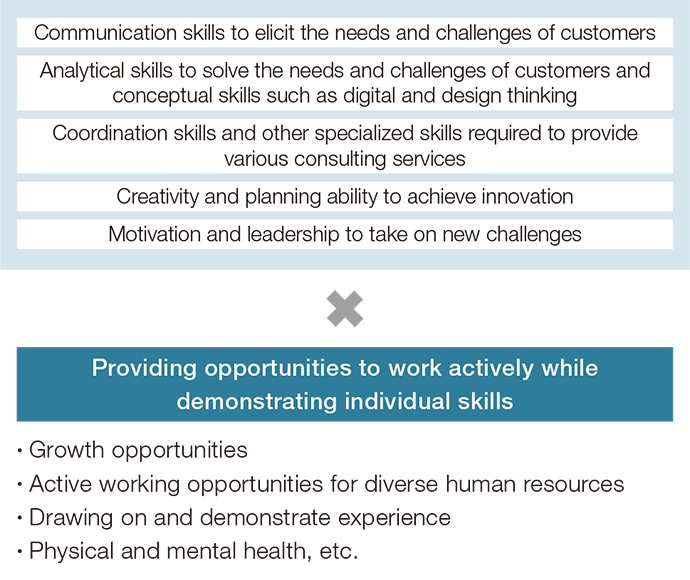
Human Resources Development Policy
To improve problem-solving skills among employees to live up to the expectations and trust of customers, we will work to secure and develop human resources capable of creating new value by developing human resources with specialized skills and meeting the diversified needs of customers.
We will also enhance human resources capable of continuing to adapt to changes in the business environment in the future by enhancing opportunities for reskilling.
Internal Environment Development Policy
We will develop our internal environment based on the following policies so that each individual human resource with diverse knowledge and skills can fully demonstrate their abilities.
1.Organizational culture to encourage autonomous growth
To promote autonomous growth and a motivation to take on challenges among employees, we will cultivate an organizational culture where employees have a sense that their performance and contributions are properly valued and can feel their own growth and where employees continue to create new value by autonomously carving out their careers. Furthermore, we will create an environment where motivated and skilled employees can work actively and shine in a higher field.
2.Diversity and inclusion
In order to remain a corporate group where each individual employee can work actively and grow sustainably, we will form a diverse and self-reliant group to strengthen our organizational power by leveraging diverse views and experience of individual employees irrespective of their age, gender, and other properties.
In order that diverse human resources can work actively in the long term in the Group, we will work to develop a pleasant working environment and develop related systems, while taking into account changes in lifestyles and attitude toward work.
3.Health Management
We recognize that it is essential that employees are healthy both physically and mentally in order to contribute to the development of local communities and regional economy. Based on this recognition, we provide support for employees to maintain and improve their health so that every employee can work energetically in good health and thus can fully demonstrate their abilities.
【Long-term vision and Human capital】
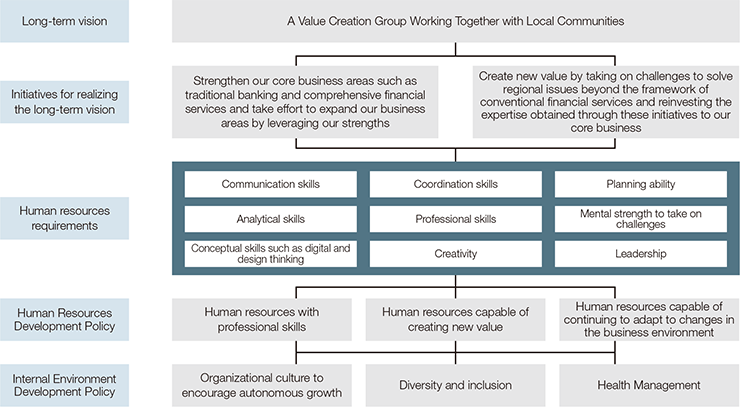
Current status of initiatives
Main initiatives in the Medium-Term Group Business Plan
【Basic Strategy 3: Develop human resources and promote active participation】
We have endeavored to develop and secure human resources who live up to the expectations and trust of customers. Specifically, we have made efforts to establish an environment that allows diverse human resources to participate in workplace more actively, including the enhancement of training programs and reskilling opportunities.
In addition, we are aiming to develop our working environment. To this end, we will expand the opportunities for motivated human resources to actively participate in workplace by introducing a new personnel system, and will help them achieve a better work-life balance so we can provide support for the workstyle of each of our employees by enhancing related systems.
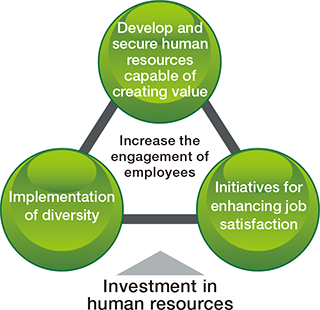
1.Status of initiatives for human resources development
We are working to develop highly skilled human resources with problem-solving skills by enhancing opportunities for internal and external training and by dispatching trainees and accepting secondees from outside the Group. At the same time, we are striving to secure external work-ready human resources by such means as mid-career hiring. We are also working to undertake reskilling measures to cope with the advancement of digitalization and DX and provide common training programs at the Group’s subsidiary banks.
To give an example of the progress that has been made in the “promoting digitalization” set as one of the key issues (materiality) for the Group Sustainability Policy, as a result of our efforts to encourage and train employees to acquire IT Passport with the target of achieving 3,000 acquirers by the end of March 2024 to early develop and secure DX basis personnel (IT Passport holders) who will act as the basis for providing support for local communities and customers with their DX and promoting the Group’s DX, we have already achieved the target of 3,000 acquirers more than one year ahead of schedule at the end of December 2022.
Number of DX basis personnel (IT passport holders) (Bank total)
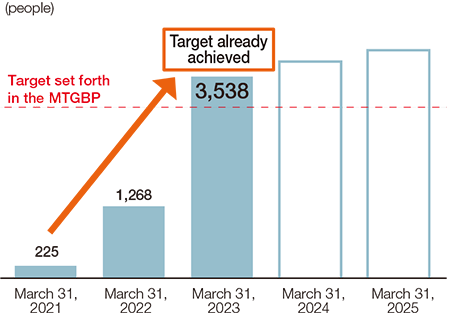
2.Status of initiatives for internal environment development
(1)Organizational culture to encourage autonomous growth
We are endeavoring to create an environment to provide employees with support for self-motivated career building and promote their motivation to take on challenges. Such initiatives include implementing a measure to clarify skills required to be acquired by employees in each field and department to evaluate and certify their acquired skills; introducing a program that allows employees to volunteer to serve as trainees dispatched to inside and outside the banks* or participate in training; assigning to certain departments by open recruitment; holding various holiday lecturers and workshops; and enhancing e-learning programs.
In addition to the above, we are seeking to cultivate an organizational culture where employees can feel enhanced job satisfaction by developing related systems to improve their work-life balance.
Number of newly dispatched trainees to inside and outside the banks
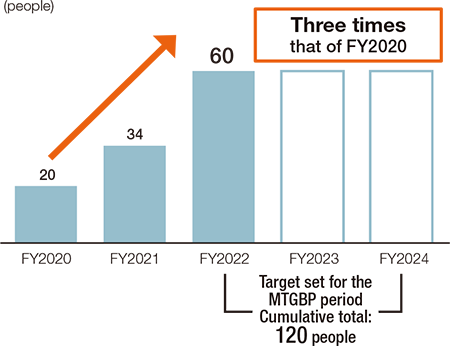
※Trainees dispatched to inside and outside the banks: trainees who are dispatched for a more than one month with the aim of developing human resources
(2)Diversity and inclusion
We have led the active participation of group-wide female employees and strengthened initiatives for enhancing opportunities for female employees to actively participate in workplace and for promoting them to higher managerial positions, including holding “Mebuki Women’s Class,” a class for fostering women leaders who serve as role models for young female employees. In addition, we have been working to develop related systems, such as paid holidays and leave systems and shorter working hours, and deepen company-wide understanding of these systems so that employees can select their workstyles in tune with life events and balance work and family.
Also, we are making efforts to encourage all employees to achieve early personal growth while giving utmost consideration to diversifying individual lifestyles and sense of value and provide fair opportunities for career advancement. In the meantime, both of our subsidiary banks have revised their personnel systems designed to promote highly motivated and capable employees to higher positions irrespective of their age, gender, and nationality, etc. The systems have been put in place to realize a highly convincing and fair pay scheme to pay employees commensurate with the difficulty of and contributions made by their assigned tasks so that all employees can fully demonstrate their abilities.
In conjunction with the revisions to the personnel systems, we are also working to enhance opportunities for ever increasing senior human resources to actively participate in workplace, drawing on their skills and experience.
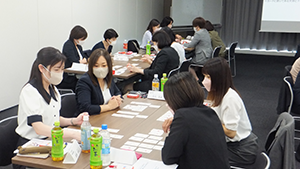
Mebuki Women’s Class
(3)Health Management
In accordance with the Health Management Declaration, we have been making efforts to detect diseases at early stage and prevent disease aggravation and development of lifestyle diseases among employees by such means as offering complete medical checkup and periodic health checkup programs, from the perspective of maintaining and improving their physical health. Amid the COVID-19 pandemic, we have been taking various measures to prevent the spread of infection among employees. Such measures include speeding up vaccination by offering workplace vaccination to help as many applicants as possible get vaccinated early.
At the same time, we are also working to improve physical and mental health among employees by undertaking initiatives for mental health promotion, such as conducting a stress check and setting up counselling desks for all employees, as well as those for achieving a better work-life balance.
We believe that realizing a better life of employees in terms of asset building has a positive effect on their physical and mental health and is imperative for the Group and employees to grow together. Based on this belief, we are working to enhance our welfare program, including a shareholder association and defined contribution pension plan, to support their asset building.

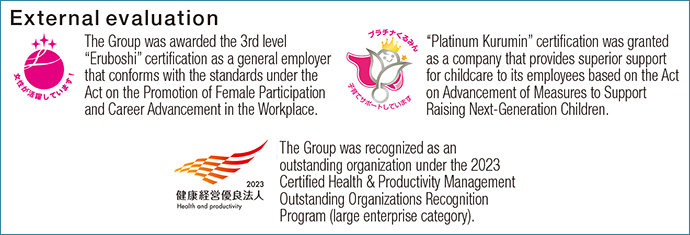
【Initiatives for financial wellness】
The Group offers various systems designed to support asset building of our employees. Meantime, we provide various menus and financial education also from the perspective of supporting asset building of corporate customers’ employees.

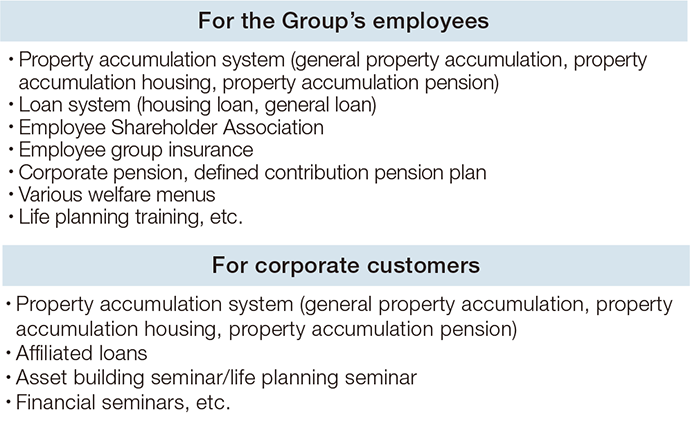
Risks and opportunities associated with human resources management (risk management)
Regarding human resources as an important factor in the evolution of the Group’s business and the execution of business strategies, we address risks associated with human capital based on our recognition that such risks can be either risks and opportunities depending on how we address them.
We acknowledge the need for strengthening our investment in human capital, while addressing risks and opportunities associated with human capital based on the recognition described below.
Direction of our response to risks and opportunities based on environmental awareness, etc.
1.Rapid changes in the external environment and diversifying lifestyles and sense of value
| Changes in social and economic trends and environmental awareness | The speed of environmental changes is becoming faster and the environment is likely to continue to change drastically. Also, there is an increasing awareness among individuals of social issues, such as sharing economy, increased experiential consumption, decarbonization, and SDGs. We recognize that, amid increasing uncertainty in our surrounding environment, our stakeholders expect the Group to contribute to realizing sustainable local communities and it is necessary for us to transform the Group’s business by developing and securing human resources capable of creating value as well as through the radiance of our employees. |
|---|---|
| Risks |
Delays in adaptation to changes in the external environment and a failure to meet the diversifying needs of customers due to the lack of securing and developing human resources will result in:
|
| Opportunities |
Adapting to changes in the external environment and enhancing human resources capable of meeting the needs of customers will lead to:
|
| Direction of initiatives |
【Secure human resources】
【Develop human resources】
|
2.Diversity and changes in workstyles
| Changes in social and economic trends and environmental awareness | The promotion of the active participation of not only women but also diverse human resources in workplace is attracting the attention of society. There is also a growing trend in corporate innovation through the mobilization of human resources, such as second job and mid-career hiring, and the utilization of human resources with different corporate cultures. Due also to the COVID-19 pandemic, various workstyles that do not require a commute to an office, including working from home and teleworking, have been spreading rapidly and become popular. These workstyles are expected to continue to be adopted and take root even after the COVID-19 pandemic is over. |
|---|---|
| Risks |
Failing to enable diverse human resources to fully demonstrate their abilities and to adapt to changes in workstyles and attitude toward work will result in:
|
| Opportunities |
Enhancing diversity measures, creating a workplace without gender disparities, and reviewing ways of working will lead to:
|
| Direction of initiatives |
|
3.Declining birth rate and growing aging population
| Changes in social and economic trends and environmental awareness | Amid concerns over the declining vitality of local communities resulting from the accelerating regional imbalance of population, we recognize that it is necessary for us to develop an environment where employees in the middle of child-rearing and those in the senior years can work with a sense of security and where employees and their families can lead a better life. |
|---|---|
| Risks |
Declining working population will result in:
An increasing need for nursing care of parents, etc. will result in:
|
| Opportunities |
Securing diverse workers and ensuring diverse workstyles will lead to:
|
| Direction of initiatives |
|
4.Advancement of DX and digitalization
| Changes in social and economic trends and environmental awareness | The prolonged COVID-19 pandemic has further amplified and spurred the wave of digitalization. We recognize that it is necessary for the Group to promote DX by drastically reviewing how its business and operations should be and that the speed and methods of response to ever-accelerating digitalization are risks that affect the growth of the entire Group. |
|---|---|
| Risks |
Delays in response to DX and digitalization due to the shortage of highly specialized human resources will result in:
|
| Opportunities |
Advancing DX and digitalization by enhancing highly specialized human resources will lead to:
|
| Direction of initiatives |
|
5.Ensuring compliance
| Changes in social and economic trends and environmental awareness | When it comes to compliance, it is much more important to make a judgment from the perspective of whether the action is socially acceptable than just comply with laws, regulations and other rules. We recognize that having such a perspective is an important theme to realize sustainable corporate activities, and expectations and demand for corporate social responsibility are expected to grow further. |
|---|---|
| Risks |
A decline in moral among employees will result in:
The occurrence of mental health problems, harassments, long working hours will result in:
|
| Opportunities |
Raising the ethical standards and integrity of employees will lead to:
|
| Direction of initiatives |
|
Indicators and targets for human resources management
The Group monitors initiatives for human resources management through various indicators.
Progress against these goals and indicators is regularly reported and monitored at sustainability committee and board of directors reflecting in strategies.
We will continue to conduct gap analysis to visualize and advance human resources management.
Indicators and targets for the approach to human resources development
1.Human resources development
The Group regards the development and securing of consulting personnel capable of taking actions to identify and solve challenges faced by local communities and customers from multiple angles as an initiative that we should focus on for the time being.
We have set forth targets for developing DX personnel and DX basis personnel in the Third Medium-Term Group Business Plan and worked to achieve the targets from the perspective of urgently developing and securing personnel who will adapt to the recent advancement of DX and digitalization and act as the basis for reforming the Group’s business model and providing support for customers with their DX and digitalization.
As the scope of consulting services is broad, non DX-related indicators could be an option. However, we have set the numbers of advanced qualification holders (total number of 1st grade Certified Skilled Workers of Financial Planning (1st grade FP), Small and Medium Enterprise Management Consultants (SME Management Consultants), and Securities Analysts) and 2nd grade Certified Skilled Workers of Financial Planning (2nd grade FP) as indicators as the Group’s core business is finance. In addition, we are working on the development and securing of specialized human resources by encouraging employees to acquire qualifications specific to their areas of expertise.
Targets: Results of developing DX personnel and DX basis personnel
| Target | Target date of achievement |
March 31, 2021 | March 31, 2022 | March 31, 2023 | Progress rate |
||||
|---|---|---|---|---|---|---|---|---|---|
| Number of people |
Ratio to total employees |
Number of people |
Ratio to total employees |
Number of people |
Ratio to total employees |
||||
| DX personnel | ― | ― | ― | ― | 551 | 9.9% | 137.8% | ||
| o/w Joyo Bank | 400 people | March 31, 2025 | ― | ― | ― | ― | 253 | 8.2% | ― |
| o/w Ashikaga Bank | ― | ― | ― | ― | 298 | 11.9% | ― | ||
| DX basis personnel (IT passport acquirers) |
225 | 3.8% | 1,268 | 21.7% | 3,538 | 63.3% | 117.9% | ||
| o/w Joyo Bank | 3,000 people | March 31, 2024 | 146 | 4.5% | 1,057 | 32.9% | 1,911 | 61.9% | ― |
| o/w Ashikaga Bank | 79 | 2.9% | 211 | 8.1% | 1,627 | 65.2% | ― | ||
DX personnel:head office staff certified as personnel who plan and drive new business creation and business innovation using digital technology,
and personnel who can provide DX support to customers under requirements set by each subsidiary bank
Indicators: Actual numbers of advanced qualification holders and 2nd grade FP
| Indicator | March 31, 2021 | March 31, 2022 | March 31, 2023 | |||
|---|---|---|---|---|---|---|
| Number of people |
Ratio to total employees |
Number of people |
Ratio to total employees |
Number of people |
Ratio to total employees |
|
| Number of advanced qualification holders |
433 | 7.3% | 470 | 8.1% | 476 | 8.5% |
| o/w Joyo Bank | 246 | 7.5% | 257 | 8.0% | 263 | 8.5% |
| o/w Ashikaga Bank | 187 | 6.9% | 213 | 8.1% | 213 | 8.5% |
| Number of 2nd grade FP | 3,359 | 56.3% | 3,511 | 60.2% | 3,638 | 65.1% |
| o/w Joyo Bank | 2,066 | 63.2% | 2,144 | 66.7% | 2,185 | 70.6% |
| o/w Ashikaga Bank | 1,293 | 47.9% | 1,367 | 52.2% | 1,453 | 58.2% |
Number of advanced qualification holders: total number of 1st grade FP, SME Management Consultants, and Securities Analysts
Breakdown of advanced qualification holders
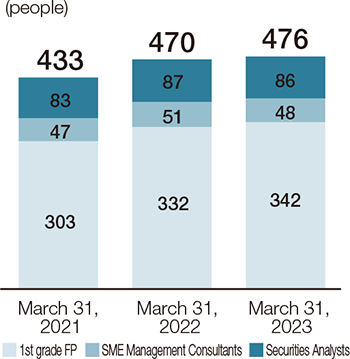
2.Securing of human resources
We recognize that, in order to achieve sustainable growth, it is important to work not only on stable new graduate and semi-recent graduate hiring but also on securing human resources with skills necessary to execute our business strategies in accordance with the expansion of business areas, deepening of consulting functions, and progress in the business strategies as there is an imbalance in the age structure of the Group’s human resources portfolio.
As part of such efforts, we will strengthen the midcareer recruiting of highly skilled and specialized, work-ready human resources. Therefore, we have set the number of mid-career recruitment as an indicator.
Indicator: Actual number of mid-career recruitment
| Indicator | FY2020 | FY2021 | FY2022 | |||
|---|---|---|---|---|---|---|
| Number of people |
Ratio of mid-career |
Number of people |
Ratio of mid-career |
Number of people |
Ratio of mid-career |
|
| Number of mid-career | 32 | 11.1% | 23 | 8.8% | 30 | 14.4% |
| o/w Joyo Bank | 13 | 8.3% | 9 | 6.7% | 12 | 11.7% |
| o/w Ashikaga Bank | 19 | 14.6% | 14 | 11.2% | 18 | 17.0% |
Ratio of mid-career: Number of mid-career ÷ Number of annual
Indicators and targets for the approach to internal environment development
1.Organizational culture to encourage autonomous growth
The Group believes that self-motivated efforts made by individual employees to improve their skills and build their careers will lead to individual and organizational growth as well as organizational revitalization and building of a strong organization and therefore enable us to realize our management strategies. It is essential for the Group to provide continuous support for employees to acquire specialized skills and draw on their expertise in a variety of contexts and from multiple angles. We therefore set the number of trainees dispatched to inside and outside the Group to have an opportunity to grow by volunteering to absorb knowledge from inside and outside the Group as a target, and the numbers of applicants for open recruitment of trainees and the post challenge program and people dispatched and assigned under these programs as indicators.
In addition, based on a recognition that it is necessary for employees to have a certain level of skills in a broad range of operations in order to be observant and draw on their expertise in a variety of contexts and from multiple angles, we have set the number of people attended training in multiple fields as an indicator.
In addition to efforts made for these indicators and targets, we are undertaking initiatives to create an environment to provide employees with support for self-motivated career building and promote their motivation to take on challenges, including holding various holiday lecturers and workshops and enhancing e-learning programs.
Target: Actual number of trainees dispatched to inside and outside the Group
| Target | Implementation period |
FY2020 | FY2021 | FY2022 | Progress rate |
||||
|---|---|---|---|---|---|---|---|---|---|
| Number of people |
Ratio to total employees |
Number of people |
Ratio to total employees |
Number of people |
Ratio to total employees |
||||
| Number of trainees dispatched to inside and outside the Group |
20 | 0.3% | 34 | 0.6% | 60 | 1.1% | 50.0% | ||
| o/w Joyo Bank | 120 people | April 2022 to March 2025 |
13 | 0.4% | 23 | 0.7% | 46 | 1.5% | ― |
| o/w Ashikaga Bank | 7 | 0.3% | 11 | 0.4% | 14 | 0.6% | ― | ||
Indicators: Actual numbers of applicants for open recruitment of trainees and the post challenge program, and people dispatched and assigned under these programs and the number of people attended training in multiple fields
| Indicator | FY2020 | FY2021 | FY2022 | |||
|---|---|---|---|---|---|---|
| Number of people |
Ratio to total employees |
Number of people |
Ratio to total employees |
Number of people |
Ratio to total employees |
|
| Number of applicants for open recruitment of trainees and the post challenge program※1 |
26 | 0.4% | 49 | 0.8% | 74 | 1.3% |
| o/w Joyo Bank | 25 | 0.8% | 28 | 0.9% | 52 | 1.7% |
| o/w Ashikaga Bank | 1 | 0.0% | 21 | 0.8% | 22 | 0.9% |
| Number of people dispatched and assigned under the open recruitment of trainees and the post challenge program※1 |
6 | 0.1% | 10 | 0.2% | 32 | 0.6% |
| o/w Joyo Bank | 6 | 0.2% | 6 | 0.2% | 28 | 0.9% |
| o/w Ashikaga Bank | 0 | 0.0% | 4 | 0.2% | 4 | 0.2% |
| Number of people attended training in multiple fields※2 |
720 | 12.1% | 1,491 | 25.6% | 1,593 | 28.5% |
| o/w Joyo Bank | 329 | 10.1% | 779 | 24.2% | 519 | 16.8% |
| o/w Ashikaga Bank | 391 | 14.5% | 712 | 27.2% | 1,074 | 43.0% |
※1 Number and ratio to the total of employees who volunteered to apply for and be dispatched as trainees or assigned to certain positions
※2 Number and ratio to the total of employees who attended training in a variety of categories (excluding part-timers and holiday lecturers)
2.Diversity and inclusion
Based on the Group’s human resources portfolio, we recognized that, in order to embody the corporate philosophy and improve corporate value by adapting to rapid changes in the external environment and creating value, it is imperative for the Group to utilize diverse human resources, including women, seniors, and specialized mid-career hires with various experience and to continuously create an environment where they can fully demonstrate their characteristics and abilities.
As part of measures to leverage diverse views and experience and increase candidates for the positions responsible for organizational management and decision-making, we have strengthened initiatives for enhancing opportunities for female employees to actively participate in workplace and for promoting them to higher managerial positions. In addition, we have been working to develop and enhance related systems, such as paid holidays and leave systems and shorter working hours, and deepen company-wide understanding of these systems so that employees can select their workstyles in tune with life events and balance work and family. We have set the ratio of female employees in assistant manager positions or higher as a target, while setting the number and ratio of female employees returned from childcare leave as an indicator for the state of securing the pool of future management candidates, in addition to the other two indicators set under the Act on the Promotion of Female Participation and Career Advancement in the Workplace, the ratio of female employees in manager positions or higher and gender wage gap.
We will create new value and innovations by building an organization that can leverage diverse views and experience, where diverse human resources can feel job satisfaction, thereby achieving sustainable growth.
Target: Actual ratio of female employees in assistant manager positions or higher
| Target | Target date of achievement |
End of FY2020 | End of FY2021 | End of FY2022 | Progress rate | ||||
|---|---|---|---|---|---|---|---|---|---|
| Number of people |
Ratio of female employees |
Number of people |
Ratio of female employees |
Number of people |
Ratio of female employees |
||||
| Ratio of female employees in assistant manager positions or higher |
1,132 | 30.0% | 1,174 | 31.4% | 1,238 | 33.3% | 95.1% | ||
| o/w Joyo Bank | 35% or higher | March 31, 2025 | 442 | 24.2% | 490 | 26.5% | 550 | 29.5% | ― |
| o/w Ashikaga Bank | 690 | 35.4% | 684 | 36.1% | 688 | 37.1% | ― | ||
Indicators: Actual ratio of female employees in manager positions or higher and the number and ratio of female employees returned from childcare leave
| Indicator | End of FY2020 | End of FY2021 | End of FY2022 | |||
|---|---|---|---|---|---|---|
| Number of people |
Ratio of female employees |
Number of people |
Ratio of female employees |
Number of people |
Ratio of female employees |
|
| Ratio of female employees in manager positions or higher |
390 | 15.2% | 428 | 16.9% | 492 | 19.3% |
| o/w Joyo Bank | 143 | 11.5% | 170 | 13.6% | 212 | 16.5% |
| o/w Ashikaga Bank | 247 | 18.7% | 258 | 20.1% | 280 | 22.3% |
| Indicator | FY2020 | FY2021 | FY2022 | |||
|---|---|---|---|---|---|---|
| Number of people |
Ratio of female employees returned to work |
Number of people |
Ratio of female employees returned to work |
Number of people |
Ratio of female employees returned to work |
|
| Number※1 and ratio※2 of female employees returned from childcare leave |
134 | 95.0% | 151 | 95.5% | 132 | 95.7% |
| o/w Joyo Bank | 91 | 96.8% | 91 | 94.8% | 78 | 96.3% |
| o/w Ashikaga Bank | 43 | 91.5% | 60 | 96.8% | 54 | 94.7% |
※1 Number of female employees returned from maternity leave and childcare leave (“Childcare Leave, etc.”)
※2 Total number of female employees returned from Childcare Leave, etc. ÷ Total number of female employees supposed to have returned from Childcare Leave, etc. × 100
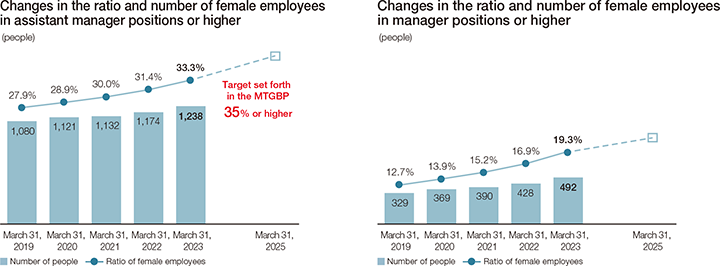
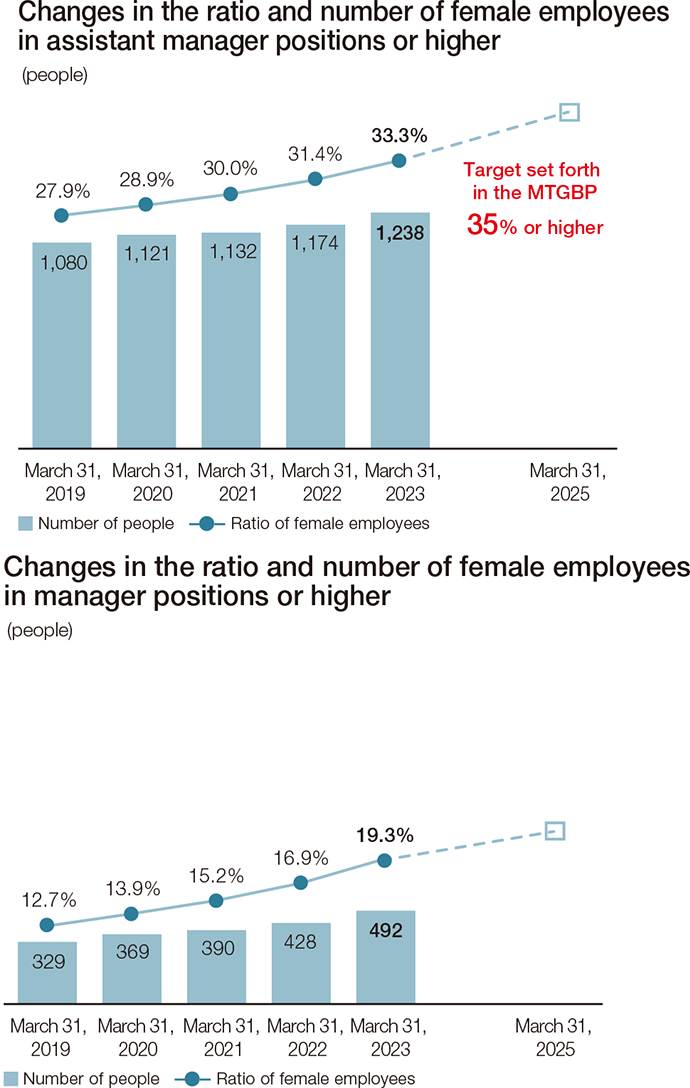
There is no gender wage gap for employees in the same courses, the same positions, or the same lines of work.
As shown in the table below, there is a gender wage gap in the aggregate. The reasons behind the gender wage gap for different employment status are as follows.
- For regular workers, the gender wage gap is due to the personnel composition and age distribution of the Group’s human resources portfolio as well as to a lower ratio of female employees in higher managerial positions.
- For part-time and fixed-term workers, the gender wage gap is due to the fact that male employees make up more of the employment status with relatively high salary levels, such as contract bank staff, an employment status adopted for the re-employment of retired employees who used to be in managerial or higher positions.
Going forward, we will work to eliminate the gender wage gap by actively promoting female employees to higher managerial positions.
Indicator: Actual gender wage gap
| Indicator | FY2020 | FY2021 | FY2022 |
|---|---|---|---|
| Gender wage gap (regular workers) | 51.6% | 52.2% | 54.8% |
| o/w Joyo Bank | 50.3% | 52.1% | 54.5% |
| o/w Ashikaga Bank | 53.1% | 52.3% | 55.0% |
| Gender wage gap (part-time/fixed-term workers) |
36.5% | 36.5% | 34.7% |
| o/w Joyo Bank | 43.0% | 43.2% | 41.9% |
| o/w Ashikaga Bank | 31.2% | 32.0% | 31.2% |
【Personnel composition of regular workers by position】
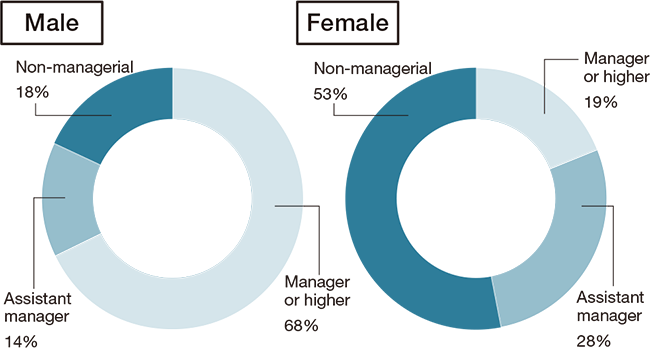
【Personnel composition of part-time/fixed-term workers by employment status】
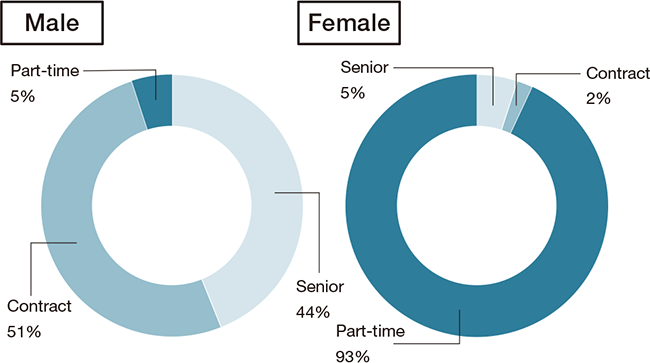
3.Health Management
The Group recognizes that, in order for a company to stay healthy, it is essential that each and every employee is healthy both physically and mentally. We provide employees with health guidance and consultation with an industrial physician to maintain and improve their health and offer a counselling service to address their mental health issues. Through such measures, we are striving to early detect employees with physical and mental health issues, while providing them with health guidance.
We have set the average number of paid leave days taken, ratio of employees who had health checkups, and ratio of employees subject to specific health guidance, as indicators for the state of Health & Productivity Management.
Indicators: Actual average number of paid leave days taken; ratio of employees who had health checkups; and ratio of employees subject to specific health guidance
| Indicator | FY2020 | FY2021 | FY2022 |
|---|---|---|---|
| Average number of paid leave days taken | 11.4 days | 11.9 days | 13.0 days |
| o/w Joyo Bank | 12.4 days | 12.4 days | 13.3 days |
| o/w Ashikaga Bank | 10.2 days | 11.4 days | 12.6 days |
| Ratio of employees who had health checkups (incl. people who had a complete medical checkup) |
99.6% | 99.9% | 99.6% |
| o/w Joyo Bank | 99.5% | 99.9% | 99.5% |
| o/w Ashikaga Bank | 99.6% | 99.8% | 99.8% |
| Ratio of employees subject to specific health guidance | 8.9% | 8.6% | 8.7% |
| o/w Joyo Bank | 8.5% | 7.7% | 8.7% |
| o/w Ashikaga Bank | 9.4% | 9.6% | 8.7% |
- Corporate Information
- IR & SR
- ESG
- Financial Statements & Integrated Report / Financial Data(Annual Report)


